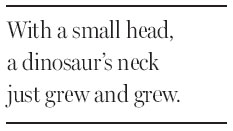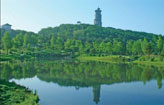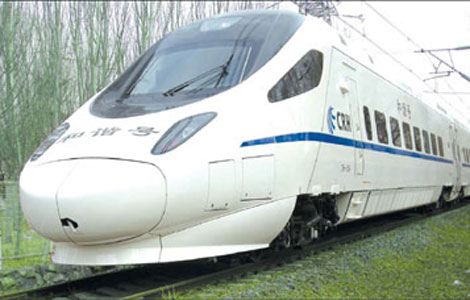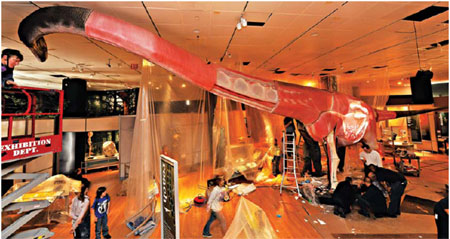Heritage
Sauropods, grazing their way to gigantic
Updated: 2011-04-24 08:05
By John Noble Wilford (New York Times)

|
A life-size replica of a sauropod at the American Museum of Natural History. They lived up to 200 million years ago. Denis Finnin / Amnh; Top, H. Train / Amnh |
No dinosaurs were quite like the sauropods. They were the biggest land animals ever, consuming everything in sight. Their necks were much longer than a giraffe's, their tails just about as long.
Scientists are redoubling their study of the unusual biology of these amazing plant-eaters of the Mesozoic era, particularly Apatosaurus (formerly known as Brontosaurus), Brachiosaurus and Diplodocus. By what physiological strategy of heart, lungs and metabolism were the largest of sauropod species able to thrive over a span of 140 million years? How did they possibly get enough to eat to grow to lengths of 4.6 meters to 46 meters and estimated weights of up to 70 tons? (A mere elephant has to eat 18 hours a day.)
For more than seven years, a group of German and Swiss scientists have tried to answer these and other questions. Findings by many other scientists have been reviewed and analyzed, then tested with new experiments.
"We actually have been re-engineering a sauropod," said P. Martin Sander, a paleontologist at the University of Bonn and leader of the team. "We are looking for physical advantages it had over other large animals."
One clear explanation has emerged: reaching all around with their long necks, these giants gulped down enormous meals. With no molars in their relatively small heads, they let the digestive juices of their capacious bodies break down their heaping intake.
This was seemingly the only efficient way for sauropods to satisfy their appetites and to diversify into some 120 genera, beginning more than 200 million years ago. They eventually dominated the land, dying out with all nonavian dinosaurs 65 million years ago.
 |
The researchers have now weighed in with their comprehensive report, "Biology of the Sauropod Dinosaurs." Dr. Sander is one of the book's editors and also guest curator of a major exhibition, "The World's Largest Dinosaurs," at the American Museum of Natural History in Manhattan, scheduled to run until January 2.
The show will feature a life-size model of an 18-meter female Mamenchisaurus, whose fossilized bones were discovered in China. It lived 160 million years ago and possibly lived in a herd. It weighed 12 metric tons and ate 522 kilograms of vegetation a day. The model's 9-meter neck and small skull illustrate the sauropods' remarkable biology and behavior.
The researchers focused on the giants' biological makeup. Dr. Sander noted that the new study was one of the few dinosaur projects in which paleontologists were outnumbered by nonpaleontologists, mainly biologists.
The animals had the longest necks for their body size of any dinosaur known. Dr. Sander and his colleagues think that the absence of mastication and its egg-laying reproduction are responsible.
By not chewing, the animals had no need for a full set of large teeth or strong jaws. They had only incisors up front for cropping and cutting vegetation, so their heads remained small and lightweight. An African elephant, for example, has a 454-kilogram head; a Mamenchisaurus head weighed 20 kilograms.
A small head, of course, took a load off the neck, presumably allowing it to grow longer. Even so, the neck had to be bolstered with more vertebrae than mammals have. Mammals, even the giraffe with a 1.8-meter neck, are limited to no more than 7 neck vertebrae; the Mamenchisaurus neck had 19 lightweight bones, hollowed out with air pockets.
The neck gave these animals an ability to graze a much wider radius of ground vegetation without moving a step. Sauropods could outcompete other plant eaters and over time, and as one scientist wrote, "enter the niche of giants." And gigantism was perhaps their best defense against predators.
Another primitive feature, egg-laying, increased the number of offspring and thus improved the chances of long-term survival of species - and time to innovate.
In a preliminary finding, Dr. Sander and Marcus Clauss, a dinosaur specialist at the University of Zurich, wrote that sauropods gradually evolved what appeared to be a high growth rate, a birdlike respiratory system and a flexible metabolic rate. Dr. Sander cited the bird-lung model as an important innovation. "If an elephant had birdlike lungs, it would grow even bigger," he speculated.
Dr. Clauss wrote that these giants could be "a rare example of herbivores that actually benefit from an increase in body size."
The bigger they got, in other words, the greater their capacity to store vast food intake.
Dr. Clauss of Zurich and Jurgen Hummel of the University of Bonn conducted fermentation experiments to estimate that the giants probably took two weeks to digest an all-day dinner.
Other scientists, who are not involved in the study, said the research was impressive.
"I'm not sure they've hit the nail on the head, always," Peter Dodson, a University of Pennsylvania paleontologist, said. "But they have certainly a number of important insights."
The New York Times
E-paper

Blowing in the wind
High-Flyers from around the world recently traveled to home of the kite for a very special event.
Image maker
Changing fortunes
Two motherlands
Specials

Models gear up car sales
Beauty helps steer buyers as market accelerates.

Urban breathing space
City park at heart of Changchun positions itself as top tourism attraction

On a roll
Auto hub Changchun also sets its sight on taking lead in railway sector

